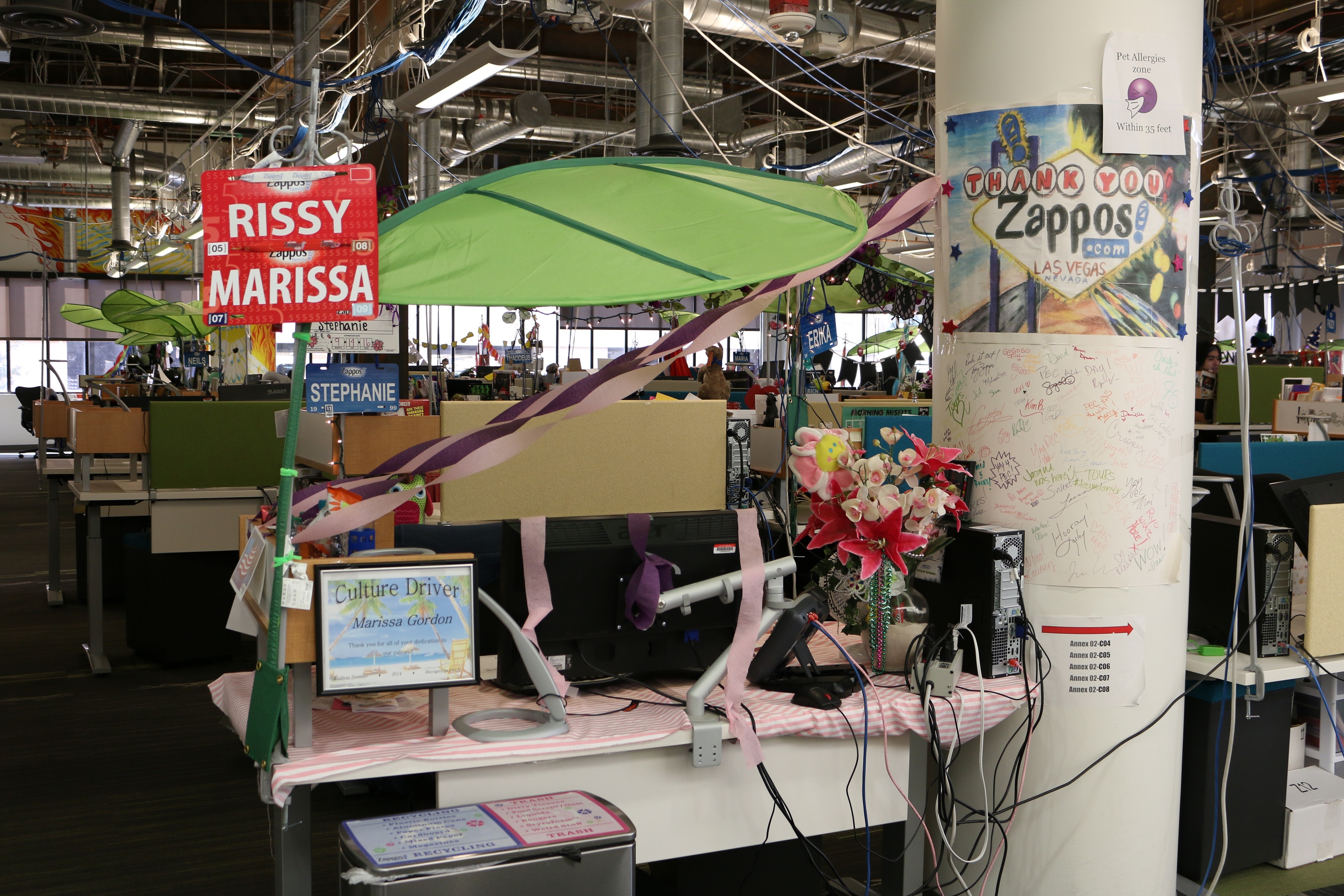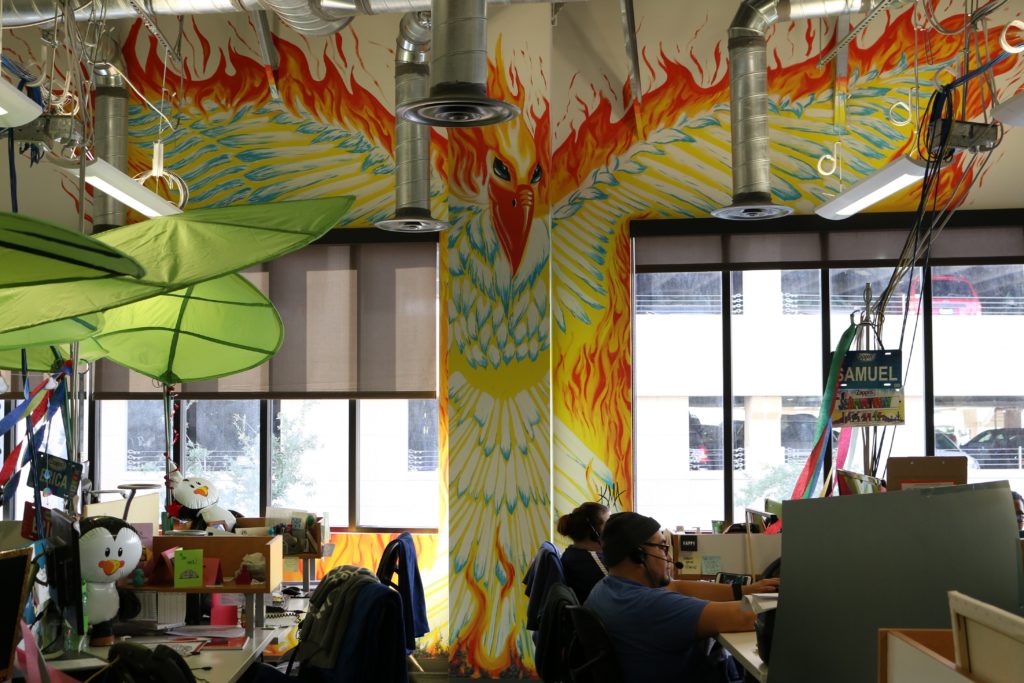Creative Thinking
4 Ways Zappos’ Organizational Culture Inspires Creativity
By Taylor Holland on October 27, 2016
Zappos employees don't have to go far for a good scare this Halloween. They need only pop down to the basement of the company's Las Vegas headquarters. There, for the ninth year in a row, an elaborate haunted house has been constructed by the finance team.
Yes, the finance team. Not marketers, designers, or other teams from whom one would expect such creative thinking, but a group of number crunchers who love to scare the pants off their colleagues.
The organizational culture at Zappos fosters so much creativity that it's oozing out of every department-and marketing is no exception.
Take, for example, the Porta-Party-which the "Brand Aura circle" (a.k.a., the brand marketing team) unveiled earlier this year at the Life Is Beautiful music festival in downtown Las Vegas. As part of the company's mission to "deliver wow" by turning "unwows" into "wows," they transformed a small trailer into a one-of-a-kind bathroom experience, complete with a trigger-activated Zappos "squatty," the "Perfect Selfie Station," a dual-soap-dispenser voting system, TVs, music, lights, and a host of other cool technology.
The project garnered press coverage and social media buzz, and several other big festivals have reached out about renting the Porta-Party for their own events.
What does "pooping in a porta-party" have to do with the Zappos brand? "Our company's purpose statement is to live and deliver wow," says brand marketer Tyler Williams. "Anything that supports that statement is OK. Traditional marketing teams do ad buys or clever commercials. We feel like going into a place most people dread and then turning it into a great experience gives customers greater attachment and affinity for Zappos. From a marketing perspective, it's very simple: We're just trying to be fun, unique, and maybe a little irreverent. We believe the highest level of achievement in marketing is to get somebody to say 'wow.' It's not whether we sold something on the website."
These are just two examples of the creative thinking Zappos has come to be known for. In fact, one of the company's core values is to "be adventurous, creative and open minded." And Zappos' unique organizational culture has been carefully constructed to help employees live up to that goal.
A Creative Business Model
Zappos' culture is legendary. The online retailer was one of the first big companies with an open floor plan and no corner offices. Customer service representatives have the same authority as the CEO to help customers who call in with complaints. Heck, CEO Tony Hsieh literally wrote the book on employee engagement and organizational culture: The New York Times bestseller Delivering Happiness. And culture is so important at Zappos that the company offers new hires $2,000 to quit after they complete training if they feel it's not the right fit.
Zappos has been so celebrated for its culture and corporate values that the company now has a consulting team that helps other businesses improve their cultures, and offers leadership training courses like the "3-Day Culture Camp" and the "School of Wow."
Of course, Zappos also sells shoes-and lots of them. Founded in 1999, the company now has roughly 1,500 employees and more than $2 billion in annual revenue. Amazon purchased the business for $1.2 billion in 2009, but left Hsieh and the rest of the management team to run the company as a wholly owned subsidiary.
 Three years ago, Hsieh decided to take Zappos in a bold new direction. Worried that corporate growth was undermining the culture that made his company great and that this would eventually lead to the "death" of the business-he instituted holacracy, a self-management business model in which teams are replaced by concentric circles, managers become "lead links" who have very little formal authority over other employees, and everyone in the company is empowered to make decisions.
Three years ago, Hsieh decided to take Zappos in a bold new direction. Worried that corporate growth was undermining the culture that made his company great and that this would eventually lead to the "death" of the business-he instituted holacracy, a self-management business model in which teams are replaced by concentric circles, managers become "lead links" who have very little formal authority over other employees, and everyone in the company is empowered to make decisions.
It hasn't been an easy road for the company. Hsieh offered generous severance packages to anyone who chose to leave during the transition. Around 18 percent took buyouts, and another 11 percent left later, without a package. And this is the first year in nearly a decade that Zappos didn't make Fortune's annual list of "Top 100 Companies to Work For."
On the other hand, Hsieh has noted that Zappos achieved its highest operating profits ever last year, and the remaining Zapponians feel that after a couple bumpy years, the team has found its holacracy groove. And while they're still ironing out some of the kinks-like putting processes in place to ensure self-management doesn't hinder teamwork-they're also seeing the benefits of the untraditional system.
One of those benefits: heightened creativity.
Williams, who serves as lead link for the Brand Aura circle, is a big believer in holacracy and the creativity that it inspires. In my recent interview with Williams, he explained: "Traditional hierarchies were set up in the belief that people don't want to show up for work, that they're lazy and the only way you can get quality work out of somebody is to manage them, and that's not the case. People are more effective and more creative when they feel ownership. They want to be proud of the work they do, regardless of whether it's managing a finance spreadsheet or doing a marketing campaign. People will put their heart and soul into something for less payoff and less money when they feel like they're the owners of it."
Of course, not every company is ready for holacracy, nor should every company try to copy Zappos' unique culture. But for marketing leaders who want to inspire more creative thinking among their teams, there's nowhere better to look for best practices.
4 Ways Zappos Fosters a Culture of Creativity
What's in the secret sauce in Zappos' creative culture?
1. Encouragement of Individuality and Team Spirit
Many companies limit the number of personal items employees can put on their desks and expect teams to keep workspaces neat and orderly. But the Zappos office looks like a cross between an elementary school classroom and a college dorm room. Streamers hang from the ceiling. Walls are covered with posters and employee artwork. And each desk reflects the unique personality of its owner.

"We really strive to bring our full selves to work," says Jovahn Bergeron, a content publisher in the Brand Aura circle. "I came from fine dining, so there was a fine dining version of myself and an off-work version of myself. Here at Zappos, we believe that since you're going to be spending 40+ hours a week here, you should be able to integrate your full self when you come to work-meaning wear the clothes you want to wear, decorate your desk the way you want to decorate. That's huge for creativity."
Zappos also encourages each circle to express its group personality. For example, the company is now piloting an internal market-based system for conference rooms. Each team decorates a conference room and then "rents" it out to other groups for meetings.
Williams' favorite room is owned by Zappos Production Group. "They have all this handmade furniture that says our corporate values. They decorated with monkeys and installed an ice machine. It's beyond ridiculous, but now everybody wants to rent that room because it's so awesome. That's just one example of how creativity gets rewarded and how the best ideas rise to the top, purely through supply and demand, and this kind of fun market-based system."
2. Established Trust
Sometimes the best, most creative ideas sound stupid at first. The Porta-Party, for example, is a pretty outlandish marketing tool, especially for an online shoe retailer. But Zappos thrives on crazy ideas, and getting people to open up and share them requires serious trust among team members.
"Somebody in our group had been thinking about just how terrible porta-potty experiences are," recalls Williams. "So they threw out the idea to create a Porta-Party. It was completely out-there, but everyone in the room laughed and then started talking about our most terrible porta-potty experiences. A year later, we have a working Porta-Party. It's one of the greatest marketing ideas we've had in a long time, and it came from somebody feeling the freedom to bring up a topic like pooping in a porta-potty."
Williams says such creative thinking requires a culture where people feel safe and trust the people with whom they work. "When you're in a boardroom with a bunch of people in suits, you tend not to bring your crazy ideas because you want to play it safe. We actually come up with a lot of our marketing ideas at a bar having drinks. We're technically off the clock, but we talk about work, because we're passionate about it. At Zappos, we invest into happy hours and team building. That makes people a lot more effective and creative in the workplace, because they trust each other."
As the lead link for his circle, Williams also trusts team members to run with their crazy ideas, even if he doesn't exactly understand them. For example, when the employee who runs Zappos' Snapchat channel proposed having a local celebrity named DJ Khaled make in-person customer deliveries, Williams had no idea who this DJ was or how the idea could be a valuable marketing campaign. But he trusted the employee and gave him the extra budget needed to make it happen.
"In most marketing departments, you have to get buy-in from different groups to make sure an idea is safe enough to try," says Williams. "That didn't have to happen here. It was just a quick phone call. And because there's that trust, I said, 'Go for it.' And it worked. Our Snapchat numbers more than doubled, and we got a lot of traction to our website."
3. Creative Freedom
Most companies aren't ready or willing to offer the complete freedom that comes with holacracy, but giving employees a long leash to run with their creative instincts can lead to more innovative ideas.
Bergeron, who creates content for Zappos' new blog Beyond the Box, has creative freedom to go find and tell great stories, to test new marketing strategies, and to showcase the brand in an innovative way.
"I started this position prior to the platform being ready to launch," he recalls. "Tyler [Williams] told me, 'Hey buddy. Just go get content. I really don't care what it is, as long as it gets us views and tells that Zappos story.' So I went out and filmed a lot of different events and things we're doing on campus that really show off our culture. People at Zappos are accustomed to seeing a pool in the middle of our plaza or unicorns running around spreading confetti on people. It's normal to us, but it seems really foreign to outsiders and makes for great content. Having that creative freedom allows me to come up with content on the fly and figure out the best way to tell that story."
For example, Bergeron is currenting working on a multimedia piece with Phil So-Zappos' resident musician-about the "Sounds of Zappos."
"I thought a story piece on Phil would be amazing, but I also wanted to make it dynamic and interesting. I originally planned to take him to a record store, blindfold him, find three random albums, and have him create a song out of it. But from a legal standpoint, we can't utilize other people's music. Since 'do more with less' is one of our core values, I said, 'What if we just go record random sounds here on campus?' Now we have sounds of keys jingling, jumping on the stairs, typing, and other odd sound effects. He's using those to create a full-on song, and I think this could actually be an ongoing feature. So maybe next month with the holiday season, we do all Christmas sounds and have him make a Christmas jingle. Nobody told me to go get this content. It's just something I thought might trend well and get us some traction, and it correlates really well with 'do more with less.'"
4. Willingness to Fail
Zappos wants crazy, fun ideas, so the company provides a safe space for employees to share and explore their creativity. But not all ideas turn into successful strategies, especially in marketing. And at Zappos, that's perfectly OK.
"For people on your team to truly feel trusted and safe, they must also understand that it's okay to fail," says Williams. "As a leader, it's important to showcase the good that comes from failure. One of my favorite things is when I see somebody go, 'Well, that didn't work. But this is what we learned and how we can do it better next time.' That means they're innovating, because they should fail 10:1 over success. In marketing, everybody says they know what they're doing, but nobody really does. So we celebrate success. Then we go fail some more before we hit the number with something again. That's what a great marketing team does-they fail over and over until they succeed, and then they move on to the next thing."
This is exactly the mind-set that Bergeron is using as he tests out content on the new Beyond the Box blog.
"From a customer perspective, we don't know yet what they want to see," says Bergeron. "We could make a video on how to style your boots, and that thing could go viral, and we could find out that how-to videos are one good strategy for us. Or this story that I'm doing with Phil is another good example. When I see these types of videos on YouTube, they have hundreds or thousands of views. So I always think, 'How can we create something ongoing that builds a fan base and gets people to come back to our platform?' Maybe that's an employee spotlight, a music series, a series of pictures of all the pets at Zappos. I don't know, but we can test and try new things. The worst case is that we don't get views or clicks. Then we know that's not a good story or there's maybe a better way to tell it."
As Zappos continues to experiment with the blog and other content marketing strategies, Williams feels confident that his team will continue to find creative ways to engage their audience. Some will work, and others won't. But he is sure about one thing: The culture of creativity will lead the way.
"If you get the culture right, it's the foundation for everything else," Williams concludes. "You can directly correlate Zappos' ups and downs over the years with how healthy our culture is or was. I can say that with 100 percent confidence."
For more fresh perspectives on today's marketing trends, subscribe to our monthly newsletter, Content & Context.

